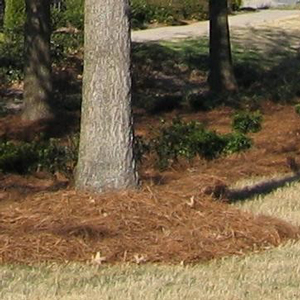Apply That Mulch With Insects in Mind
By Chris Williams on April 4, 2013.
 Insects love mulch. Burrowing under mulch provides wonderful protection from the elements and from predators. Mulch retains moisture, vital for most insects, and remains cool in summer and warm in winter. Many insects feed on decaying vegetation, and that’s basically what decomposing mulch is. If you’re a predatory insect, the mulch environment provides easy food in the form of insect prey.
Insects love mulch. Burrowing under mulch provides wonderful protection from the elements and from predators. Mulch retains moisture, vital for most insects, and remains cool in summer and warm in winter. Many insects feed on decaying vegetation, and that’s basically what decomposing mulch is. If you’re a predatory insect, the mulch environment provides easy food in the form of insect prey.
Gardeners and landscapers love mulch, too. It holds moisture for plants, subdues weeds, provides nutrients, and let’s face it—it looks nice. Gardeners prefer organic mulches like shredded hardwood, pine bark chips, straw, pine needles, and grass clippings. When these plant-based mulches decompose, they add nutrients to the soil that benefit plants.
The Pests In Your Mulch
Outdoor insects and other arthropods that become indoor pests are usually those that live around the foundation of our homes. These pests are in the mulch under the groundcover, and around the flowers and shrubs that we plant close to the walls of our homes. They like the protection and the warmth of the house, and they really love the five inches of mulch that you’ve provided. Pests that are commonly found in mulch around the foundation of a home are millipedes, centipedes, earwigs, sowbugs, pillbugs, ground beetles, cockroaches, crickets, spiders, ants, and many others. When their protective mulch becomes too dry, or sometimes too wet, these pests migrate and often find their way inside.
You can find termites in mulch, too. When wood mulch is piled around a building’s foundation, it can provide a route for termites to enter your home. The moisture in mulch allows termites to travel above ground, avoiding any insecticide termite treatment in the soil. They can move from mulch through a weep hole in the brick, a crack in the block, or through a conduit.
Mulching properly can help reduce the number of insects around the perimeter of your home, and consequently the number than can end up inside. How can you do what’s right for your plants and keep your yard looking good without creating a pest problem?
There Are Other Options – One solution to the mulch-pest dilemma: use organic mulches in your garden and around plants that are away from the foundation. But use inorganic mulches against the foundation. Inorganic mulches are nonplant materials that are not so attractive to insects and other pests. Consider inorganics like gravel, pebbles, rock chips crushed stone, plastic film, and even woven landscaping fabrics.
Another option is to leave a dry, mulch-free strip directly against the exterior wall of your home. Leave a 1-2 foot wide strip of bare ground all the way around your house, or place crushed stone or pebbles over landscaping fabric as a border. Begin your mulching on the other side of this protective barrier.
If you must mulch, don’t over do it. Most of us pile it on too thick. Mulch that is too dense remains wet too long, speeding up rotting. Shredded wood and bark mulches should be no deeper than 2 to 3 inches after settling. Coarser mulches like pine bark nuggets that have spaces allowing air circulation can be deeper, up to 4 inches.
If all fails and you have a problem with foundation pests, give Colonial a call. We have a preventive maintenance program designed specifically to keep crawling insects out. Our technicians deliver two seasonal exterior treatments each year, and you don’t even have to be home.